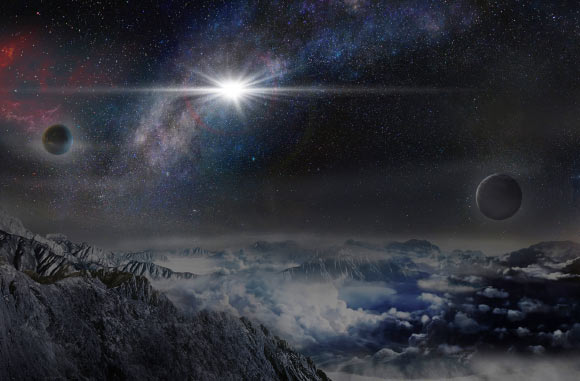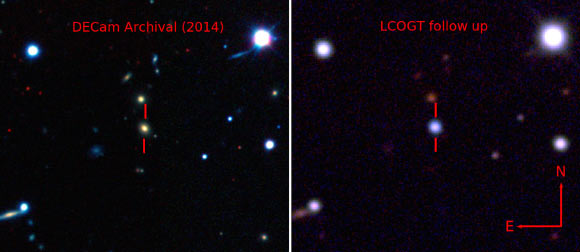A large international team of astronomers has spotted an extremely luminous supernova in a massive galaxy 3.82 billion light-years away.

An artist’s impression of ASASSN-15lh as it would appear from an exoplanet located 10,000 light years away in the host galaxy. Image credit: Jin Ma / Beijing Planetarium.
The newly-discovered stellar explosion, dubbed ASASSN-15lh, belongs to the most luminous class of supernovae called superluminous supernovae.
“It appears to originate in a large quiescent galaxy, in contrast to most superluminous supernovae, which typically come from star-forming dwarf galaxies,” Kavli Institute for Astronomy and Astrophysics astronomer Dr. Subo Dong and co-authors wrote in a paper in the journal Science.
“We estimate an effective radius for the galaxy of 7,830 light-years and a stellar mass of 200 billion solar masses.”
Also known as SN 2015L, ASASSN-15lh is approximately 200 times more powerful than a typical Type Ia supernova, 570 billion times brighter than our Sun, and twenty times brighter than all the stars in our own Milky Way Galaxy combined.
It is more than twice as luminous as the previous record-holding supernova, iPTF13ajg.
“ASASSN-15lh reached an absolute magnitude of minus 23.5 and bolometric luminosity 2.2 x 1045 ergs/s, which is more than twice as luminous as any previously known supernova,” the astronomers said.
“We have to ask, how is that even possible? It takes a lot of energy to shine that bright, and that energy has to come from somewhere,” said co-author Prof. Krzysztof Stanek of the Ohio State University.
“The honest answer is at this point that we do not know what could be the power source for ASASSN-15lh,” Dr. Dong added.
“The discovery may lead to new thinking and new observations of the whole class of superluminous supernova.”

Left: pseudo-color image of the host galaxy before the explosion of ASASSN-15lh taken by the Dark Energy Camera. Right: image of ASASSN-15lh by the Las Cumbres Observatory Global Telescope Network. Image credit: Dark Energy Survey / B. Shappee / ASAS-SN Team.
Co-author Prof. Todd Thompson, also from the Ohio State University, explained: “ASASSN-15lh could have spawned an extremely rare type of star called a millisecond magnetar, a rapidly spinning and very dense star with a very strong magnetic field.”
To shine so bright, this magnetar would also have to spin at least 1,000 times a second, and convert all that rotational energy to light with almost 100% efficiency.
It would be the most extreme example of a magnetar that astronomers believe to be physically possible.
“Given those constraints, will we ever see anything more luminous than this? If it truly is a magnetar, then the answer is basically no,” Prof. Thompson said.
_____
Subo Dong et al. 2016. ASASSN-15lh: A highly super-luminous supernova. Science, vol. 351, no. 6270, pp. 257-260; doi: 10.1126/science.aac9613







